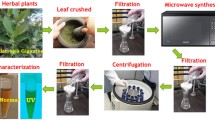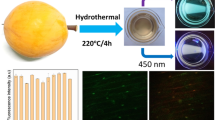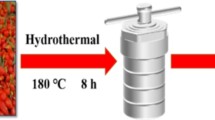Abstract
The calabura fruit (Muntingia calabura L.), one of the Neotropical trees with a high carbonate content, has been overlooked as an abundant fruit in Vietnam. In order to employ it as a reproducible raw resource with a credible application, an eco-friendly approach needs to be considerably developed for its use to be effective. Here, using a one-pot hydrothermal process, M. calabura was transformed into attractive fluorescent carbon nanoparticles (CNPs). The optical and structural properties of the synthesized CNPs were analyzed using UV–Vis absorption, photoluminescence (PL) spectroscopy, TEM, Raman, and Fourier transform infrared spectroscopy (FTIR). According to the analysis, CNPs have an average diameter of ~ 25.9 nm. Interestingly, selective quenching of CNPs’ fluorescence by Fe3+ occurred in the range of 27 to 200 µM, with a detection limit of 43.7 µM. Furthermore, a probe of calabura fruit-derived CNPs in bioimaging was successfully applied to mesenchymal stem cells (MSCs). Based on the findings, it would be beneficial to focus on creating CNPs structures with improved quality for sensing and biological applications.
Graphical abstract





Similar content being viewed by others
Data availability
Data supporting this study are included within the article.
References
W. Zhang, L. Jia, X. Guo, R. Yang, Y. Zhang, Z. Zhao, Green synthesis of up- and down-conversion photoluminescent carbon dots from coffee beans for Fe3+ detection and cell imaging. Analyst 144(24), 7421–7431 (2019). https://doi.org/10.1039/C9AN01953G
J. Xu, X. Jie, F. Xie, H. Yang, W. Wei, Z. Xia, Flavonoid moiety-incorporated carbon dots for ultrasensitive and highly selective fluorescence detection and removal of Pb2+. Nano Res. 11, 3648–3657 (2018). https://doi.org/10.1007/s12274-017-1931-6
M. Zulfajri, G. Gedda, C.-J. Chang, Y.-P. Chang, G.G. Huang, Cranberry beans derived carbon dots as a potential fluorescence sensor for selective detection of Fe3+ ions in aqueous solution. ACS Omega 4(13), 15382–15392 (2019). https://doi.org/10.1021/acsomega.9b01333
A. Xu, G. Wang, Y. Li, H. Dong, S. Yang, P. He, G.J.S. Ding, Carbon-based quantum dots with solid-state photoluminescent: mechanism, implementation, and application. Small 16(48), 2004621 (2020). https://doi.org/10.1002/smll.202070262
H. Ding, X.-H. Li, X.-B. Chen, J.-S. Wei, X.-B. Li, H.-M. Xiong, Surface states of carbon dots and their influences on luminescence. J. Appl. Phys. 127(23), 231101 (2020). https://doi.org/10.1063/1.5143819
X. Gao, Y. Lu, R. Zhang, S. He, J. Ju, M. Liu, L. Li, W. Chen, One-pot synthesis of carbon nanodots for fluorescence turn-on detection of Ag+ based on the Ag+-induced enhancement of fluorescence. J. Mater. Chem. C 3(10), 2302–2309 (2015). https://doi.org/10.1039/C4TC02582B
S.D.T. Landa, N.K.R. Bogireddy, I. Kaur, V. Batra, V. Agarwal, Heavy metal ion detection using green precursor derived carbon dots. Iscience (2022). https://doi.org/10.1016/j.isci.2022.103816
A. Shander, M.D. Cappellini, L.T. Goodnough, Iron overload and toxicity: the hidden risk of multiple blood transfusions. Vox Sang. 97(3), 185–197 (2009). https://doi.org/10.1111/j.1423-0410.2009.01207.x
G.J. Kontoghiorghes, C.N. Kontoghiorghe, Iron and chelation in biochemistry and medicine: new approaches to controlling iron metabolism and treating related diseases. Cells 9(6), 1456 (2020). https://doi.org/10.3390/cells9061456
D. Witkowska, J. Słowik, K. Chilicka, Heavy metals and human health: possible exposure pathways and the competition for protein binding sites. Molecules 26(19), 6060 (2021). https://doi.org/10.3390/molecules26196060
M. Nagaraj, S. Ramalingam, C. Murugan, S. Aldawood, J.-O. Jin, I. Choi, M. Kim, Detection of Fe3+ ions in aqueous environment using fluorescent carbon quantum dots synthesized from endosperm of Borassus flabellifer. Environ. Res. 212, 113273 (2022). https://doi.org/10.1016/j.envres.2022.113273
P. Zhao, Q. Zhang, J. Cao, C. Qian, J. Ye, S. Xu, Y. Zhang, Y. Li, Facile and green synthesis of highly fluorescent carbon quantum dots from water hyacinth for the detection of ferric iron and cellular imaging. Nanomaterials 12(9), 1528 (2022). https://doi.org/10.3390/nano12091528
W. Meng, X. Bai, B. Wang, Z. Liu, S. Lu, B. Yang, Biomass-derived carbon dots and their applications. Energy Environ. Mater. 2(3), 172–192 (2019). https://doi.org/10.1002/eem2.12038
H. Pereira, Chemical composition and variability of cork from Quercus suber L. Wood Sci. Technol. 22(3), 211–218 (1988). https://doi.org/10.1007/BF00386015
N.K. Quang, N.N. Hieu, V.V.Q. Bao, V.T. Phuoc, L.Q. Doc, N.M. Tri, C.T.C. Ha, Hydrothermal synthesis of carbon nanodots from waste wine cork and their use in biocompatible fluorescence imaging. N. Carbon Mater. 37(3), 595–602 (2022). https://doi.org/10.1016/S1872-5805(22)60608-5
N.K. Quang, L.V.T. Son, Sensitive detection of Fe3+ ions and cell imaging of carbon nanodots derived from canistel (Pouteria campechiana). MRS Adv. 7(13), 278–283 (2022). https://doi.org/10.1557/s43580-022-00267-6
A.M. Nima, P. Amritha, V. Lalan, G. Subodh, Green synthesis of blue-fluorescent carbon nanospheres from the pith of tapioca (Manihot esculenta) stem for Fe(III) detection. J. Mater. Sci. Mater. Electron. 31, 21767–21778 (2020). https://doi.org/10.1007/s10854-020-04689-6
R. Purbia, S. Paria, A simple turn on fluorescent sensor for the selective detection of thiamine using coconut water derived luminescent carbon dots. Biosens. Bioelectron. 79, 467–475 (2016). https://doi.org/10.1016/j.bios.2015.12.087
H. Li, Z. Kang, Y. Liu, S.-T. Lee, Carbon nanodots: synthesis, properties and applications. J. Mater. Chem. 22(46), 24230–24253 (2012). https://doi.org/10.1039/C2JM34690G
L. Ðorđević, F. Arcudi, M. Cacioppo, M. Prato, A multifunctional chemical toolbox to engineer carbon dots for biomedical and energy applications. Nat. Nanotechnol. 17(2), 112–130 (2022). https://doi.org/10.1038/s41565-021-01051-7
N. Rabiee, S. Iravani, R.S. Varma, Biowaste-derived carbon dots: a perspective on biomedical potentials. Molecules 27(19), 6186 (2022). https://doi.org/10.3390/molecules27196186
H. Shabbir, E. Csapó, M. Wojnicki, Carbon quantum dots: the role of surface functional groups and proposed mechanisms for metal ion sensing. Inorganics 11(6), 262 (2023). https://doi.org/10.3390/inorganics11060262
W. Lu, X. Qin, S. Liu, G. Chang, Y. Zhang, Y. Luo, A.M. Asiri, A.O. Al-Youbi, X. Sun, Economical, green synthesis of fluorescent carbon nanoparticles and their use as probes for sensitive and selective detection of mercury(II) ions. Anal. Chem. 84(12), 5351–5357 (2012). https://doi.org/10.1021/ac3007939
S. Sahu, B. Behera, T.K. Maiti, S. Mohapatra, Simple one-step synthesis of highly luminescent carbon dots from orange juice: application as excellent bio-imaging agents. Chem. Commun. 48(70), 8835–8837 (2012). https://doi.org/10.1039/C2CC33796G
P.-C. Hsu, P.-C. Chen, C.-M. Ou, H.-Y. Chang, H.-T. Chang, Extremely high inhibition activity of photoluminescent carbon nanodots toward cancer cells. J. Mater. Chem. B 1(13), 1774–1781 (2013). https://doi.org/10.1039/C3TB00545C
Z.-F. Pu, Q.-L. Wen, Y.-J. Yang, X.-M. Cui, J. Ling, P. Liu, Q.-E. Cao, Fluorescent carbon quantum dots synthesized using phenylalanine and citric acid for selective detection of Fe3+ ions. Spectrochim. Acta A 229, 117944 (2020). https://doi.org/10.1016/j.saa.2019.117944
S. Chandra, A.R. Chowdhuri, D. Laha, S.K. Sahu, Fabrication of nitrogen- and phosphorous-doped carbon dots by the pyrolysis method for iodide and iron(III) sensing. Luminescence 33(2), 336–344 (2018). https://doi.org/10.1002/bio.3418
V. Ramanan, S.K. Thiyagarajan, K. Raji, R. Suresh, R. Sekar, P. Ramamurthy, Outright green synthesis of fluorescent carbon dots from eutrophic algal blooms for in vitro imaging. ACS Sustain. Chem. Eng. 4(9), 4724–4731 (2016). https://doi.org/10.1021/acssuschemeng.6b00935
F. Du, M. Zhang, X. Li, J. Li, X. Jiang, Z. Li, Y. Hua, G. Shao, J. Jin, Q. Shao, Economical and green synthesis of bagasse-derived fluorescent carbon dots for biomedical applications. Nanotechnology 25(31), 315702 (2014)
S.N. Baker, G.A. Baker, Luminescent carbon nanodots: emergent nanolights. Angew. Chem. 49(38), 6726–6744 (2010). https://doi.org/10.1002/anie.200906623
Acknowledgments
We very much appreciate the preparation of the biological sample by Vo Thi Phuoc at the Biology Department of University of Sciences, Hue University. The author is grateful to Le Vu Truong Son at Da Nang University for optical measurements.
Funding
No funding was received for conducting this study.
Author information
Authors and Affiliations
Contributions
The author confirms sole responsibility for the following: study conception and design, data collection, analysis and interpretation of results, and manuscript preparation.
Corresponding author
Ethics declarations
Conflict of interest
The authors declare no conflict of interest.
Ethical approval
This research used the available biological material and followed the law and the national ethical guidelines of Vietnam (Vietnam Ministry of Health, number 4259/QĐ-BYT).
Consent for publication
Not Applicable.
Informed consent
Not Applicable.
Additional information
Publisher's Note
Springer Nature remains neutral with regard to jurisdictional claims in published maps and institutional affiliations.
Rights and permissions
Springer Nature or its licensor (e.g. a society or other partner) holds exclusive rights to this article under a publishing agreement with the author(s) or other rightsholder(s); author self-archiving of the accepted manuscript version of this article is solely governed by the terms of such publishing agreement and applicable law.
About this article
Cite this article
Quang, N.K. Sensing of Fe3+ ions and fluorescent bioimaging probes utilizing calabura fruit-derived carbon nanoparticles. MRS Advances (2024). https://doi.org/10.1557/s43580-024-00781-9
Received:
Accepted:
Published:
DOI: https://doi.org/10.1557/s43580-024-00781-9




